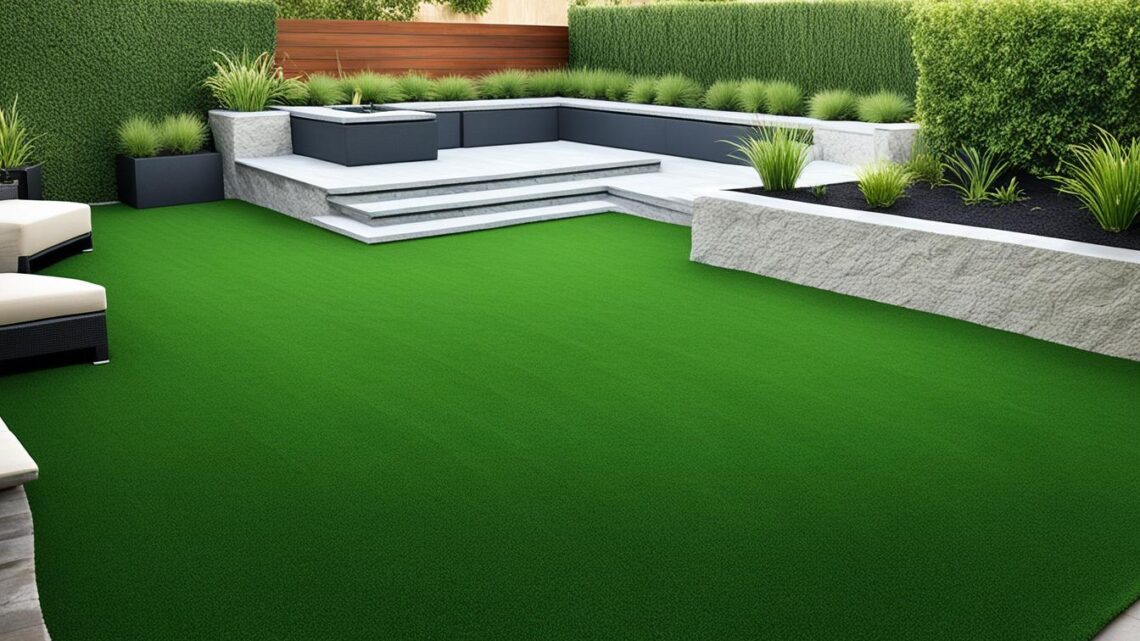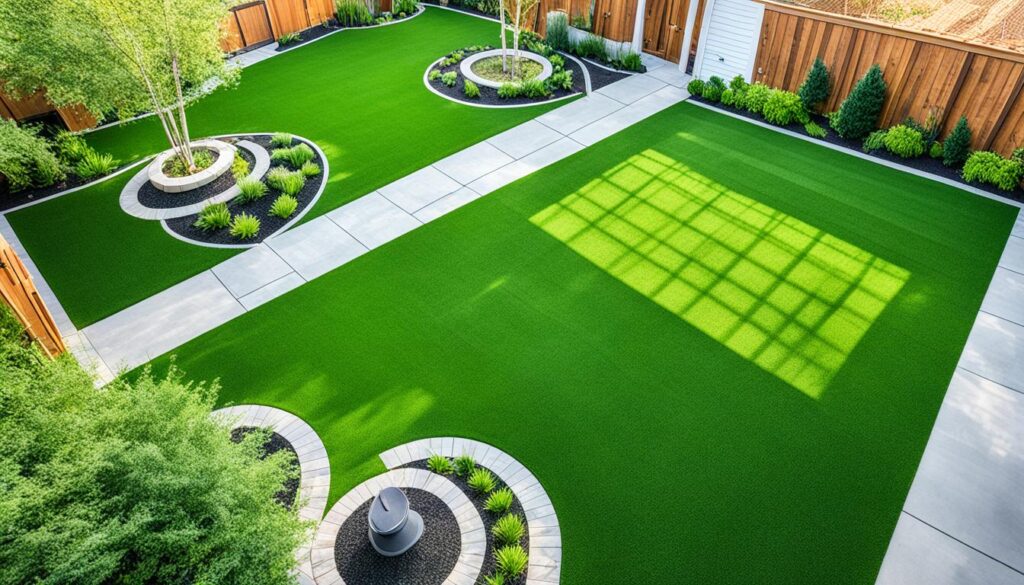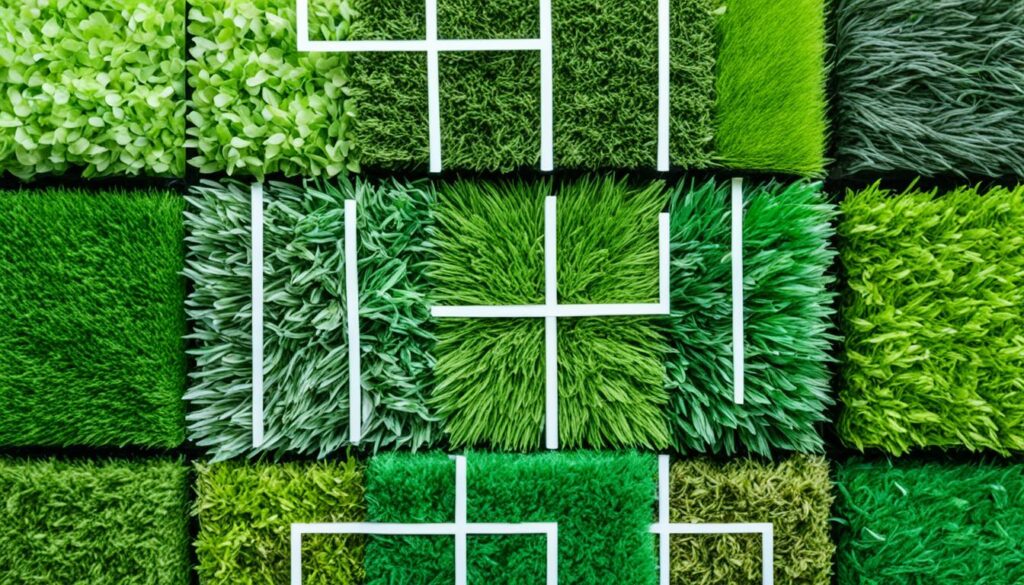
Are you tired of the constant upkeep and water use of real grass? Discover the change artificial grass can bring to your outdoor area. This guide will show you the best synthetic turf options for your needs.
From Bella Turf to Selkirk Elite, the artificial lawn world has many products. But picking the right grass alternative can be hard. This guide will help you find the best low-maintenance landscaping, pet-friendly landscaping, or drought-resistant landscaping for your space.
IN THIS ARTICLE
ToggleUnderstanding Artificial Grass Terminology
When looking for artificial grass, it’s key to know the terms used to describe it. Two main things to think about are the pile height and the infill.
Pile Height
Pile height is how long the grass blades are. Short pile heights, 3/8 to 5/8 inches, work well for busy areas like sports fields or dog runs. They are tough and last a long time. Longer pile heights, 1 1/4 to 2 1/2 inches, make your yard or patio look more real and nice.
Knowing about pile height helps you pick the right artificial grass for your needs and look.
Infill
Infill is also key to artificial grass. It’s the material between the grass blades that keeps them standing up, stabilizes the turf, and makes it feel real. You can use crumb rubber, EPDM rubber, sand, or Durafill as infill.
Each infill type has its own good and bad points. Some absorb heat, some cushion better, and some fight germs. Think about what you need and where you’ll use the grass to pick the best infill.
| Infill Type | Advantages | Disadvantages |
|---|---|---|
| Crumb Rubber | Excellent shock absorption, good drainage, and resilience | Can get hot in direct sunlight, potential health concerns |
| EPDM Rubber | Antimicrobial properties, lower heat absorption, and softer feel | More expensive than crumb rubber |
| Sand | Affordable, easy to maintain, and provides good drainage | Less cushioning and stability compared to rubber |
| Durafill | Durable, antimicrobial, and provides excellent drainage | Can be more expensive than traditional infill options |
Knowing about artificial grass terms helps you make a smart choice. This way, you get a beautiful, lasting lawn that meets your needs and likes.

Evaluating Your Artificial Grass Needs
Before you start looking for the perfect artificial grass, think about what you really need. It’s important to know what you’re looking for. This will help you pick the right kind of grass for your space and how you plan to use it.
When checking out artificial grass, think about these main points:
- Intended Use: Is the area for lots of foot traffic, like a pet area, or just for looks? What you plan to do with the grass will help pick the best type.
- Climate and Weather Conditions: Your area’s weather can affect how well the grass lasts. Choose grass with UV protection and good drainage.
- Lawn Size: Measure the area you want to cover. This helps pick the right amount of grass and the setup you’ll need.
Take your time to really think about what you need in artificial grass. Making a smart choice will give you value and good performance for a long time. The right grass can change your outdoor area, whether it’s for a easy-care backyard or a beautiful front lawn.
| Artificial Grass Needs | Factors to Consider |
|---|---|
| Intended Use | High-traffic, pet-friendly, decorative |
| Climate and Weather | UV protection, drainage systems |
| Lawn Size | Measurement, installation techniques, sub-base requirements |

best artificial grass: Choosing the Right Product
When picking the best artificial grass for your lawn, think about a few important things. The quality and how long it lasts are key. Look for a face weight over 40 ounces per square yard. This means the grass is heavy and dense, making it more durable.
The thatch layer is also crucial. It makes the grass look and feel like real grass. Choose grass with a thick thatch for a lush look. The backing and sub-base are important too. They help keep the grass stable and ensure good drainage. Make sure they’re made for high-quality artificial grass.
| Feature | Importance | Recommended Specification |
|---|---|---|
| Face Weight | Indicates quality and durability | Above 40 oz/sq yd |
| Thatch | Provides realistic appearance | Dense, lush thatch layer |
| Backing | Ensures stability and drainage | Designed for artificial grass |
| Sub-base | Supports the turf and drainage | Decomposed granite, sand, gravel |
Don’t forget to look at the warranty. A good warranty means you’re covered for a long time. By looking at all these things, you can pick the artificial grass that works best for you.

Preparing for Artificial Grass Installation
Installing artificial grass seems easy, but it’s key to prepare well for a good result. You must prepare the sub-base and make sure the area is level and drains well. Think about the space layout, if you need borders, and if you can find good installers nearby.
First, remove about 2 inches of soil for the turf base, more near the edges where roots are strong. Use a class II road base that’s 2-3 inches thick for the best base layer. For slopes up to 15 degrees, wire mesh helps keep things in place. For steeper slopes, you might need a special membrane before the road base.
Good drainage is key, especially over concrete. It stops mold and keeps the area dry. For pet areas, add a 1/4 inch of Zeofill to the base to fight odors. For places where people walk a lot or drive on the grass, use geotextile pavers for extra stability.



